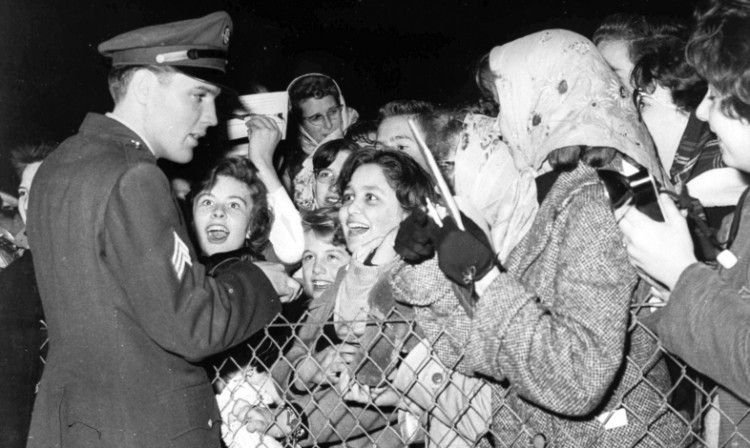
Wartime mystery, missing diamonds and Hollywood superstars…
With its no-frills flights, Elvis Woz Here plaque and dubious “pure dead brilliant” logo, Prestwick is often seen as the ugly sister of Scotland’s airports.
But that may be about to change.
Glasgow’s second airport, 32 miles down the M77 on the Ayrshire coast, has been described by one of the men behind a new festival celebrating the area’s aviation history as “Scotland’s hidden industrial gem”.
You see, there’s a lot more to Prestwick Airport than a brief stop off from a disorientated Elvis Presley.
A hundred years since the first landings at Monkton Meadows, on the northern edge of the future airport, Prestwick’s unique and colourful aviation history will be celebrated this week in the inaugural World Festival of Flight.
Prestwick Airport’s lofty story takes diversions to the first breath-taking journey over Everest, Rudolf Hess’s mysterious solo flight to Scotland, missing diamonds, Hollywood stars and a pioneering female pilot.
Festival curator George Kerevan explained: “It’s sad that Elvis has become the airport’s iconic symbol, so we want to tell people there’s more to Prestwick and our aviation history.
“It has a rich past and continues to play a major role.
“It’s a manufacturing centre a lot of jet engines are serviced there and parts of all the major airlines’ planes are built there.
“And near to the airport is the National Air Traffic Control, so even if you’re flying from Heathrow to New York, the plane will be safely directed from Prestwick.”
That first flight on July 25, 1913 was by an aircraft from the recently-formed Royal Flying Corps.
“Prestwick was attractive due to its long, flat fields and the fact that it’s fog-free due to its coastal location,” continued George.
“Throughout the 1920s small-scale airlines in Scotland were using the town’s beach and fields.”
In 1933, daredevils David McIntyre and Douglas Douglas-Hamilton risked their lives to become the first men to fly over Everest.
They had purchased some of those vast green fields to set up a training airfield.
By 1935, a hangar, offices and control tower were in place and Prestwick Airport was born.
One of the first pilots to make a name for himself, or in this case herself, was Winifred Drinkwater. She is one of the inductees to a Scottish aviation Hall of Fame.
“In 1933 she became the first woman in the world to pilot a commercial airline,” George said.
“It wasn’t until the Second World War that society’s attitudes changed to where it wasn’t unusual for a woman to be a pilot.”
Prestwick Airport had a pivotal role during the war.
“McIntyre was an organisational genius and quickly turned it into a manufacturing centre.
“All these aircraft were coming from North America and they had to be readied for the RAF with guns and navigation equipment.”
The airport is also rumoured to have been the intended destination for Hitler’s right-hand man, Rudolf Hess, whose plane crashed a short distance away in Eaglesham in 1941.
“He said he was on his way to see the aforementioned Douglas-Hamilton to negotiate a peace deal.
“But Hamilton had never met Hess and knew nothing about it,” explained George, who flew over Everest with Hamilton’s grandson earlier this year to mark the 80th anniversary of the seminal flight.
“A number of strange issues still surround Hess’s trip. We have parts of his crashed plane and they’ll be on display during the festival.”
Following the war, Prestwick Airport expanded further.
“McIntyre realised it could be the base for an international airport,” George said.
“In the 1950s, planes didn’t have enough fuel to go all the way to London or Europe from America, so they’d refuel in Prestwick.
“Frank Sinatra, Roy Rogers and his horse, Trigger, were just some of the big names to come into Prestwick.”
It wasn’t all glamour at the UK’s transatlantic hub in those early days of commercial flight.
Two serious accidents took place near Prestwick in 1948 and 1954, killing a total of 62 people.
In both instances, diamonds were also being transported on the planes and an extensive search was carried out in the area to recover them, although not all of the stones were found.
George said: “Passenger planes were prone to the weather back then and that’s what led to both of those aircraft crashing. Airlines are much safer now.”
By looking back, George and the rest of his team hope the festival promotes Scotland’s modern-day aviation industry.
“This is just the beginning and it’ll be an annual event,” enthused George. “We hope in future to excite young boys and girls into considering a career in aviation.
“It’s a growth industry and Prestwick Airport is one of Scotland’s major engineering hubs, with five major aerospace companies located there and a host of smaller ones, too.
“The airport continues to be very heavily used by freight transport, NASA, military from America, Canada and the UK, and private jets.
“It’s Scotland’s hidden industrial gem and hopefully this festival will position Prestwick as Scotland’s aerospace capital.”
Perhaps that pure dead brilliant label is apt, after all.

Enjoy the convenience of having The Sunday Post delivered as a digital ePaper straight to your smartphone, tablet or computer.
Subscribe for only £5.49 a month and enjoy all the benefits of the printed paper as a digital replica.
Subscribe